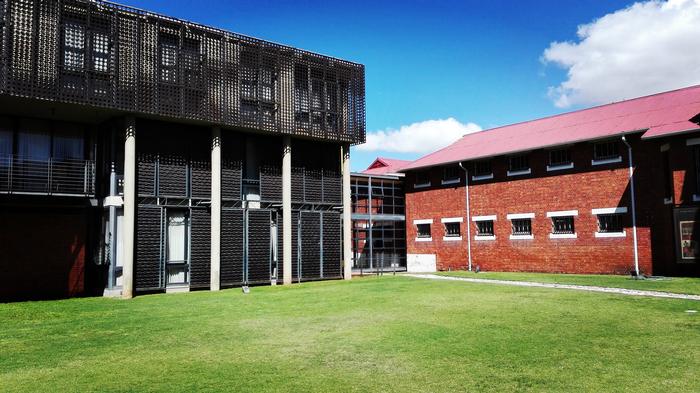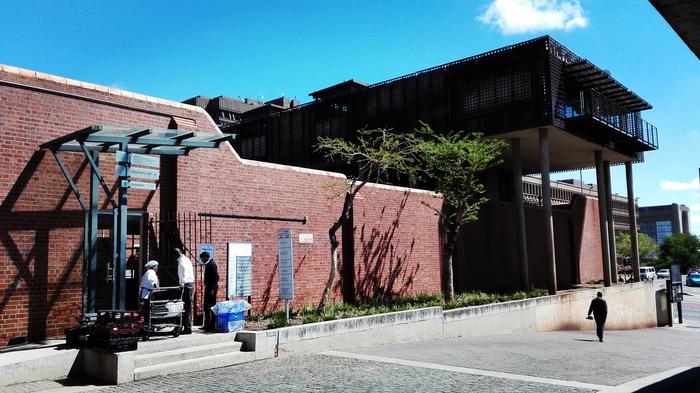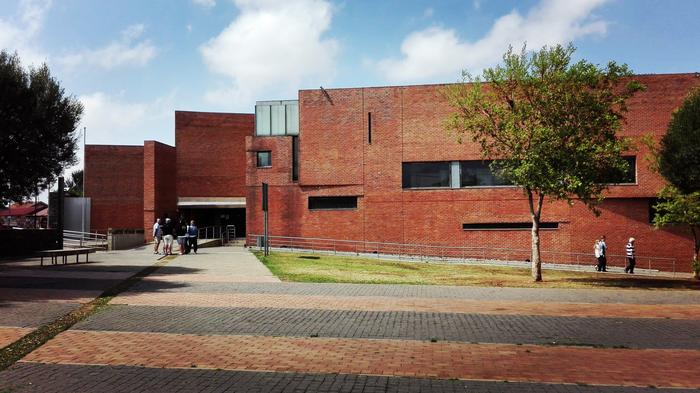Wandilise Kona EssayA Cathartic Architectural Language in a Democratic South AfricaBackground The Great Depression and World War II brought increasing economic woes to South Africa and convinced the South African government to strengthen its policies of racial segregation. After the Afrikaner National Party gained power in 1948, its all-white government began enforcing existing policies of racial segregation under a system of legislation that is called apartheid. Under apartheid, non-white South Africans (a majority of the population) would be forced to live in separate desolate areas from white South Africans and use separate public facilities, and contact between the two groups would be limited. For instance, these laws alluded to the stringent enforcing of the Afrikaans language as the medium of instruction for black South African students, nullifying the use of their preferred languages. Hence the legislation of apartheid and its laws created the sole framework for white supremacy and tyranny in South Africa, which remained in effect for the better part of 46 years. Resistance to apartheid within South Africa took on various forms, from non-violent demonstrations, protests, and strikes to political action and eventually to armed resistance. The vital resistance of these laws gave rise to prominent activism within South Africa from predominantly non-white South Africans. What transpired, in turn, was sever incarceration and execution of all anti-apartheid activists – by the apartheid government – suppressing non-white South Africans to a life of despair and terror. The Constitution Hill Women’s Jail located at the heart of Johannesburg, as an old British jail, was a notorious destination for women activists during these suppressing times. In 1976, hundreds of school pupils marched the streets of Soweto in prompt of a democratic South Africa, and the on falling acts of the Soweto student uprising earmarked the soon death of the apartheid regime. Hector Pieterson a primary school student was the first recorded pupil to be killed by the apartheid police during this time of resistance. Hence the Hector Pieterson Museum located in Soweto; a historically rich township in Johannesburg, serves as a national memorial conveying the story of the student uprising in its very structure. Essay The buildings under consideration for this year’s Question, The Women's Jail by Kate Otten Architects and the Hector Pieterson Museum by Mashabane Rose Architects are buildings that have exemplified architectural resilience in South Africa over the past decade, particularly in celebrating the fight against oppression in the post-apartheid South Africa. The buildings come into existence during a paradigm shift in the South African landscape; after the fall of the apartheid regime. So the emergence of the buildings in the new South Africa primarily deals with the redressing of their brutal political and architectural history. The social art of architecture, in this case, is the alteration of spatial meaning respectively. However in architecture, the meaning of space is never defined in isolation its meaning is tightly tied to the coherence of its immediate ecosystem; its co-existing people, nature and artefacts, set of events and function which in architecture is termed as the context or site. So in the given circumstances, the architect has rendered a disabling past with an enlightening function and intention through architectural intervention (e.g. a building). And through this design outcome, the architect has blurred out unnecessary social thresholds within the given society. This social gesture then serves to indicate the architect is not designing on voided space but thoughtfully translating one spatial meaning to another. Hence the architect respectively is charged with outlining a new foundation for a democratically empowering future in South Africa through architectural spatial making. The question of what will the new architectural language be in the post-apartheid South Africa must have been thought-provoking for spatial practitioners, particularly when it came to architectural spatial making that celebrates the fight against oppression in South Africa. I’d conclude the fact that layers of spaces had to be peeled off to find what is pure, and to separate what is worthy of being celebrated from what is not; essentially informing newly designed spaces must have been quite tricky considering the drastic change in spatial use. The design approach taken by Kate Otten Architects for The Women’s Jail deals with the mentioned concern in various ways; attempting to appropriate a new extension in a historically brutal context. The Women’s Jail as a modern office building is a new extension to the old British jail, and the jail ceasing to function as a prison is currently deemed as a national heritage site. One of the primary methods used to appropriate the new extension as a whole is the careful integration of its form and function, which to a large extent has much to do with how the building is experienced on a day-to-day basis; essentially informing its social significance. Approaching TWJ from the west, I was struck by the distinctively walled precinct leading to its north-facing entrance (this being the visitor’s entrance). The first thought that came to mind was that there had to be a good reason for this, except the architect’s intent to keep the internal space visually imprisoned from the public – this was where women activists were once imprisoned during the apartheid regime. The imprisoned space, housing a courtyard and new winged office spaces, is one of the most important spaces in this intervention as a whole, solely because of its spatial qualities and its cathartic storytelling. The prohibited visual access to the courtyard space recreates a brutal scene that used to be, and the old perimeter walls serve to be a living testimony to the prison’s function as a place of confinement. The outward form of the extension has been thoughtfully considered to depict a series of ‘cell’ blocks that are symmetrically facing each other across the courtyard – what used to be the prison exercise yard. Consequently the considered nostalgic form enhances its emotive storytelling through its materiality and function. The new buildings do not seek to imitate but they ‘touch’ the old buildings ‘lightly’, thus retaining the integrity of both the old and the new, and the new contemporary shape helps define a new order of authority within the given space. In fact what Kate Otten Architects have brilliantly achieved is blending the old and the new with ‘light’ walkways on either wing. This then creates a smooth transition from the old to the new, not just spatially but physically. The given transition ends with a grand statement – the third storey of each office wing is projected over the north-facing prison wall. This gesture echoes the transformation of the old space, from a place of confinement to its new function as an expression of freedom and democracy. As a poetic stance, the projection of the two buildings is purely thought-provoking, for the projection is said to resemble the nation’s transition from a disabling regime to a resounding democracy. Hence this level of thoughtfulness has acquired the new office building with an eloquent contemporary look; having the new office wings hovering in triumph over their architectural history. The conversion of the precinct was dealt with as a set of layers that needed to be peeled off, disposed or added to. The ‘peeling off’ process uncovered many things; original metal ceilings above gypsum ceilings in cell blocks, security grills hidden within old walls, and signage indicating the original use of various spaces. By exposing these hidden layers it provided KOA the opportunity to create healing through memory for the ex-prisoners, and to educate the public about the history of the nation. From the process of uncovering, it was also discovered that the desire for separation manifested itself even within the materials and finishes of the old building. Floor areas where the prison authorities would regularly move and work where finished in timber, whereas all the areas allocated to prisoners were left in concrete. The new extension not only exposes these devices but also destabilizes the social tensions created by them. Therefore all new office walkways are currently finished in timber. In addition, the ‘prison’ looking office spaces have been clad with perforated ‘iron’ sheeting and with time the rust has blended some of the sheeting with the old red walls of the prison, and this design decision enhances the cultural significance of the old precinct. A new glass-covered walkway currently bisects the courtyard space where previously was an iron fence. The old exercise yard has become a plane of grass retaining its prominence, but providing a public amenity for its new occupants. The walkway has been aided by a few public exhibitions – the east side of the walkway is screened with glass exhibition panels, and a red metal frame is resting on the plane of grass. Inscribed on the panels are word expressions from prominent ex-prisoners, and the red metal frame expresses a confined footprint of a demolished detention shed. This then creates an eloquent platform for the voices of the women who were once silenced by the very same space. Rather than creating a passive heritage artefact, the new alteration becomes a prompt for renewal without compromising the respect of its past. Contrasting this sacred courtyard space is the old prison atrium, which provided maximum surveillance for prison authorities. Entry to the new offices is via the old central atrium connected to cell wings and currently housing memorial exhibitions. The old buildings are then embraced and become part of the interface between the public heritage space and private office space. In the central atrium, a mountain of polishing rags narrates the endless task of polishing the prison floors, and the winged exhibitions display various aspects of the prisoner life. Thus these exhibitions demystify the tension between private memory and public memory. Moreover, the programme of the new extension is yet another grand statement by the intervention – TWJ provides office space to human rights commissions such as the Commission for Gender Equality. Joyce Piliso-Seroke former chairperson of the CGE spent solitary confinement in 1967 within the very same space, but she walked through the prison on her way to work on a daily basis. This then serves as a powerful reconciliation and cathartic mechanism for the brutal history of the site. By implementing this mechanism the intervention offers a daily opportunity to restore human dignity and constructing a democratic South Africa. However, the Hector Pieterson Museum is designed to depict a book or rather a spatial narrative, in which the narrative gives off its information through systematic circulation (a planned touring experience), and makes use of a number design tools and decisions in order to do so. And through this reading experience, the reader is projected in a time past. Approaching the given precinct from the south, the reader is welcomed by a gracefully exposed courtyard memorial – which is primarily situated where the students of 1976 were prohibited with open fire. Thus the courtyard memorial has been dedicated to cleansing this spatial horror, and the reader can immediately note this dedication by the visual amenities MRA has provided for the public. What is particularly impressive about the courtyard memorial is the simple use of various textures and change in levels in order to distinguish certain parts of its story from each other. Through this technique, the author or the architect has been able to create a legible narrative. On the south-west end of the courtyard, lies a particular rock memorial resting on the intersection of Kumalo road and Pela street. For instance, the rock sits on a circular gravel plane setting it apart from a paved surface area which progresses towards the courtyard’s main exhibition platform. As the reader approaches this public display, he or she encounters a drastic change in ground level stepping down to the actual platform. Consequently this forces the reader to experience a significant shift in attention as they engage with a primary aspect of the narrative with a bit more discretion. The openness of the courtyard creates a sensation of invitation and belonging due to its generous accessibility, as opposed to its alienating memory, and this spatial quality is particularly cathartic for the students (and represented families) who once experienced the same space differently. This sacred landscape is accessible to an outdoor water feature resting behind a granite memorial platform – the main exhibition platform – displaying the bloodshed that was once experienced within the immediate context. The water running through this feature symbolizes the blood of the students that was shed in prompt of a democratic South Africa. This ‘blood’ spills into thin groves running on the lower level of the memorial platform linking it to an artificial river. The statement made by the architect here is that even though the students were brutally killed, with the intent to prohibit them from reaching their goal, their blood achieved it either way. What stands behind the water feature on the edge of Pela street, are slate brick walls and pillars which are an expression of all the unknown youth that played a part in achieving democracy in South Africa. The walls and pillars also serve as a visual guide to the main entrance of the museum and connect the street edge activity of Pela street to the courtyard memorial. In front of this visual guide towards the north, lies a particular line of grass pointing the main entrance of the museum to the site where Hector Pieterson was shot. And across the street, behind the walls and pillars stands Mbuyisa Makhubu Primary School – a school established in memory of Mbuyisa Makhubu. He was the high school student who carried Hector Pieterson’s body in pursuit of aid; after being shot by the police. In fact what enhances the water feature is a prominent image of this particular instance. The courtyard memorial has been discretely designed to interface the school’s presence as it serves as a public amenity after schooling hours. This gesture reads off as thought-provoking since the youth of the past are standing in victory for the youth of today in an openly cathartic space. Hence the courtyard space enables the public with a graphic-awareness of the nation’s history, subsequently informing identity and further discovery. Entry to the museum introduces the reader to a series of visual and text exhibitions, and the museum space is discretely contrasted by artificial lighting creating a relatively dim exhibition space. The contrast in spatial lighting narrates the element of alienation and rejection, as opposed to the courtyard exhibition. The series of visual imagery particularly commences with a mob of students marching to Orlando West Stadium, on the date June 16th, 1976. Essentially the museum consists of a pedestrian ramp that gently progresses from the ground floor up to the first floor, and what is wrapped around by the ramped exhibition is an exposed gravel courtyard area. This area of the narrative carries dispersed granite bricks with student names and dates of death inscribed on them. Here lie all the recorded students who died due to the student uprising, and what is particularly alarming to the reader in this area is the largely corresponding to the dates of death on the various bricks. In the course of the museum, visual imagery is either aided by displayed words from politicians and student activists, police officers, and school teachers, or artefacts from the apartheid regime such as school desks and police weaponry. The exhibition ramp also consists of descriptive views of the immediate context; each view providing the reader with a brief text description of a past occurrence. And what ends this ramped exhibition is a small contemplative room; providing a solid view of the courtyard memorial and the site where Hector Pieterson was shot. This spatial conclusion then projects the reader back to the sacred landscape of reconciliation and belonging, and the reader is propelled by the replenishing of the precinct post its political history. Conclusion In summary, it is quite intriguing to understand how architecture can be utilized as a social catalyst by simply telling stories that have played a distinctive role in the course of our history as a nation and providing the public with humanitarian objectives. Kate Otten Architects and Mashabane Rose Architects deserve a standing ovation, for designing buildings that rooted themselves in their context and challenged their political history. This exhibits the power that architecture has in having an impact on the world at large, not to mention a nation. The social art of architecture should reach and touch the lives of the masses, and blur out unnecessary social thresholds as the sun would to flowers after a stormy climate. Hence the given architects allowed that which evolves to create this outstanding outcome. In tribute to Jeremy Rose co-founder of Mashabane Rose Architects - 2015 Literature Bibliography: (2009). 10 years 100 buildings. Cape Town.: Bell-Roberts Publishing. Deckler, T. Graupner, A. Rasmuss, H. (2006). Contemporary South African Architecture in a Landscape of Transition. Cape Town.: Double Storey Books. Damon, I. (2006) Digest of South African Architecture. SAIA http://www.history.com/topics/apartheid https://www.brandsouthafrica.com/south-africa-fast-facts/history-facts/womens-jail-111105
Additional Help and InformationAre you in need of assistance? Please email info@berkeleyprize.org. |
|




